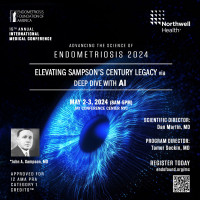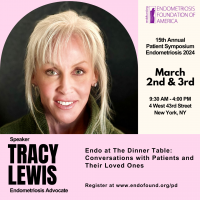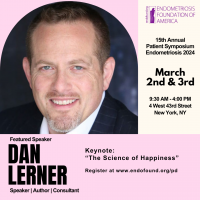Linda Griffith, PhD
Research considerations in endometriosis
Advancing the Science and Surgery of Endometriosis
Monday and Tuesday, April 18-19, 2016
The Union Club, New York
This meeting is not always perfect but it is always great! I really love coming here because it was the place I really got a first exposure to endometriosis. What I am going to talk about today are some tools that we have been trying to bring into the endometriosis research community after my coming to this meeting for many years and interacting with surgeons here. I want to especially call out Tamer and Padma for starting this meeting and Lone for helping us all stay engaged across many different kinds of disciplines.
I came into the topic I am going to talk about in sort of a back way. My research is in tissue engineering and this is from my article that Science magazine asked me and Gail Naughton to write in the early 2000s where we describe regenerative medicine applications. But at the end of the article we gave the perspective that the field was really going to move toward building in vitro models of human tissues for better drug development. This is a picture of a liver model that we had been developing in our lab that is now been commercialized and used by a lot of pharmaceutical companies in drug development. Over the past decade or so my lab and the whole field in bioengineering has moved more toward the so-called organs on chips to use in drug development. What I am showing here on this slide are a few examples from the field; work of my colleague Roger Kamm in building microvascular networks. You can see endothelial cells in a tiny gel in a micro-fluidic device. This is a picture of the device, cancer cells and immune cells moving through these patent vessels in this little device. Other examples from people in the field really trying to do tissue engineering now with devices that let you get fluid flow and so on and so forth.
This is a huge area of investment by the federal government and DARPA, the Defense Advance Research Projects Agency and NIH together are spending about $100 million in a five year Microphysiological Systems Program. I am one of the primary investigators so I have over $30 million during this time period to do research on how do we build mimics of human physiology for drug development. It is really hard to get funding for endometriosis, everyone knows that. But there are ways to get funding that you can bootstrap toward endometriosis and we have done that. My DARPA program manager has let us do that. This is a drug development pipeline and in the context of endometriosis I think about this all the time because we know it has been extremely difficult to get drug companies to develop things that are not hormonal regulators or plain inflammatories.
The part of it that we brought in to this whole program that is now very visible at NIH, I go there and I talk about endometriosis and I am going to give you a short version of this talk. What we bring in normally you have patient population going to target identification, and we had a beautiful talk today from Asgi Fazleabas about mechanisms of endometriosis regulation of gene transcription and so on, but, we also now want to think about expanding mechanisms to stratify patients. The organs on chips started out with most people thinking of using them for toxicology but we have been focusing on trying to bring them in to earlier stage drug development.
Our goal here is to start with clinical data. What is the patient population and a message from today is that we think that there may be many different subgroups of endometriosis patients – you can see Padma here, my niece here. All of them have symptoms but they may have underlying different mechanisms of disease ultimately and how can we start to tease that out. We are using this approach thinking about stratification to design in vitro systems for studying disease with a primary focus on endometriosis.
I have given talks here before where I have used this slide but it is just to orient us that we stratify patients all the time in cancer. Cancer has known genetic mutations, endometriosis no known somatic genetic mutations though there may be epigenetic modifications that are regulating the disease. Right now if you get breast cancer you are immediately stratified by three molecular markers used around the world. Those have value for prognosis and for therapy and there are targeted therapies for all of them. Can we move toward that in endometriosis?
When I started working with surgeons I found it very interesting, it is repeated over and over again, that the staging of the disease does not really predict prognosis and therapy all that well. Patients with a little bit of disease can have a lot of pain and vice versa. One of the things that came up today and I am starting to become more attuned to it is maybe some of these patients who have minimal disease and a lot of pain also have other diseases like adenomyosis that need to be attended to.
Where does this take us? I am going to do a short recap of what we published on our stratification and set the stage for tools we are bringing in the community and working with some people here and elsewhere to try to understand the cross talk between the endometrium, the peritoneal lining and peritoneal fluid in inflammation in endometriosis. Again, we heard beautiful from Asgi this morning about this cross talk as studied in baboons. We want to bring new tools that will let us take patient samples and start to study it in vitro in a defined way.
We got started in this by focusing on peritoneal fluid. Peritoneal fluid bathes the peritoneal lining. It is where a lot of inflammation is known to be taking place. We start here thinking about the communication networks between these different cell types so a level up from what Asgi talked about so you have got genetic and RNA and then you have the proteins and protein network states. Can we start to build models that let us probe the networks of communication? This is a simple version, immune cells, stromal cells, epithelial cells. Here is now starting to put layers of mechanisms of networks of things happening. Immune cells talking to each other and to the endometrial cells through cytokines but also all kinds of invasion networks regulated by proteases, regulated by growth factors, networks of things going on. Can we, as engineers, start to build a model of these networks – communication flow between cells between cells within cells to unravel the disease and most importantly, can we use these networks to maybe classify patients or start classifying them according to networks that may be most dangerous in them.
We took an approach and this had been published with _____ peritoneal fluid very easy to get, took the cells out and analyzed some of these networks. Briefly recapping work that we had published we asked if in groups of patients, we had a reasonable size patient population, all these samples, we asked are there inflammatory cytokines that change at the same time in groups of patients. We did a completely unsupervised kind of math that Netflix uses to tell you what movies to watch. We found a group of 13 cytokines that changed in concert in these patients and importantly, what does that mean, who cares? It contained patients from all stages of the disease according to the surgical classification and there were about a third of the patients with this particular signature. There was a trend toward enhanced pain. We subsequently did an initial study with Mauricio Abrao and amazingly were able to replicate the analysis identically. We have a completely different set of patient demographics because he has a different kind of practice but we came up with very similar conclusions. In fact, the same five cytokines emerged when we did a meta-analysis. That manuscript is in preparation and it is my fault that it was not published a year ago, post ___ lab and I am a very slow writer.
What we found in this study though is we identified by reverse engineering a macrophage phenotype responsible. We went back, took macrophages from patients, their peritoneal fluid and showed they were making those cytokines, controlled patients and in studying these macrophages in culture we identified jun kinase, which had not previously been identified as a major regulator of the production of these cytokines. That was very interesting. Now hold that thought about jun kinase, we then wanted to study invasion networks. Again, this is a picture from Maurizio’s surgery. I went to see him on vacation one year and he took me in the OR. It was amazing to see the whole set up he had there. He was doing a bowel resection on his patient that day. It made us really think about invasion networks.
You do not need to think about the busyness of this slide, this is simply the other part of it. We talked about immune networks and engineers like to conceptualize things, information flow. We have a cell that is getting cues from growth factors and cytokines. It goes through signaling networks and there are proteases on the surface of the cell. Enzymes that are shedding things, the receptors, the growth factors and so on, and then the cell does something, it invades. This is an engineering conceptualization. We can put math on all of those steps. We can make a network where we put rates and numbers and so on on the different steps. I am not going to try to teach you math today but what we do is build a model that we can go in and can measure all these things and it is expensive and time consuming to measure these but it helps us start to get that mechanism. Again, you do not need to know the details of this other than we can start to think about phenomena in engineering ways.
We had to invent some new ways to measure protease activity and collaborate with other people and you are familiar maybe with seeing heat maps, this is just a whole bunch of different molecules in the peritoneal fluid. This is a whole bunch of different proteases, self-surface and otherwise. We are looking at their activity, their concentrations, the point is we can get a lot of data, again, out of the peritoneal fluid and we can come back and we identified some mechanisms of invasion that again involved jun kinase. But we are really trying to ask the question “can these networks help us classify or stratify patients with protease invasion”. We were only able to do a pilot investigation because the analysis turned out to be really hard. We did nine patients and indeed we found two groups of patients separated by some protease activities. I am not going to go into the math that is the discriminant PLSR modeling but these are very provocative early data suggesting there maybe value in taking these mechanism based approaches. So, early provocative data but not definitive. We want to expand these with more studies.
What is very intriguing is there was a jun kinase inhibitor trial going on in Europe by PregLem. The trial was never published. We heard, not definitively, that some patients responded really well, others did not so the average trial could not go.
What we have been doing more recently is saying we would love to build models of how these cells are all interacting in culture so that we can actually study patient samples where we recreate these tissues in culture. This has been a huge focus lately and we are working with Asgi Fazleabas and Kevin Osteen because we got a grant to try to transfer these model cells to the community. If you do cell culture you probably use Matrigel, it is an extract of basement membrane that comes from growing a mouse tumor. You grow the tumor out, you extract this goo out. You can buy it now but it is still not a re-agent. We set out to say can we build a completely synthetic extracellular matrix that will let us rebuild the endometrium or the peritoneal lining? The salient features are epithelial cells, stromal cells and immune cells; we will do vascularization but not yet. Moreover, can we dissolve it so we can get cells and all the molecules out so that we can study them?
We want to be able to build these tissues, 3-D models and perturb them. We have come a long way towards doing that. The basic way we start is we take a completely synthetic polymer called poly-ethylene oxide. It is used very widely in biomaterials in thousands of labs, well hundreds anyway. You combine two different things together, they cross-react. They are very gentle, you can put cells in it and get a very clear gel shown here, it looks like a contact lens.
What we did was we did a lot of fancy engineering of this where we put goodies in there that will bind to the integrants – so this is showing a cell membrane, the adhesion receptors that bind to matrix naturally, bind to a little teeny-tiny mimic of a matrix protein of fibronectin, they bind to a little mimic but then we also have things that help capture things that cells secrete to make their little nests. This is a molecule called fibronectin, it is a natural part of your matrix and it is growing there.
We can now build the endometrium, beautiful epithelium and if we look beautiful stromal cells making matrix. So this is all growing in culture from human endometrial cells. We can do decidualization over a month giving hormones to cause proteins that are normally involved in decidualization to be secreted and moreover, we are now incorporating immune cells. We can put immune cells in this and they migrate around and differentiate into normal cells. We have been successful in breaking the matrix down and measuring cytokines within that matrix so now we have all these tools to really study the signaling networks in the matrix.
Finally, we are now starting to put these on our organs on chips. I have shown you everything in culture. DARPA built this huge platform with little micro-fluid ____ connect an endometrium model with a gut and liver and something else so we can actually start to look at endometrium interacting with other things.
Our goal is to really bring these kinds of tools into drug development for endometriosis. This is an example. We do not have an endometrium but this is gut liver. When they interact together through these pumps we completely rewire the function of the liver in a beautiful way. We are really moving toward in vitro physiological human on a chip. What I hope I have convinced you is that these tools may be useful in the endometriosis community for studying mechanism. That is why we are trying to get them into Asgi’s lab and Kevin’s lab and others.










